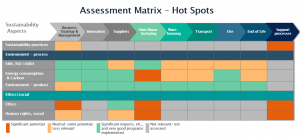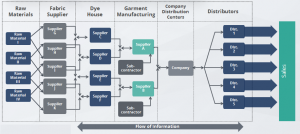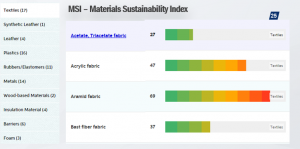You might have read or heard quite a bit about the SAC’s Higg Index lately and perhaps you are still wondering how this topic concerns you or your company.
As Leadership & Sustainability is a member and approved trainer of the SAC, we would like to give you some advanced information on the SAC’s Higg Index and explain step by step how the Higg tools fit your sustainability program whether you are a brand, retailer or manufacturer. For an overview of our SAC related services, please click here.
Therefore, in the following we will introduce the SAC’s Higg Index in brief, and have a look at the brand level and how to conduct a materiality assessment to find out what is important for your business and strategy. Then we will focus on the supply chain as well as on the impact of products and materials.
What is the vision behind the SAC?
The Sustainable Apparel Coalition (SAC) focuses on the apparel, footwear and home textiles industries, and has defined its vision as follows: “to produce no unnecessary environmental harm and have a positive impact on people and communities associated with its activities.”
The SAC works with and has almost 200 members from many different stakeholder groups including brands, retailers, manufacturers, service providers and nonprofit organizations. Its aims are to develop tools, to support the adoption of those tools and to enable transparency of results.
The Higg Index
The Higg Index represents a range of tools that can be used at each step along the supply chain. As you can see from the chart below, there are three different module categories. The Facilities Modules focus on either your own or your suppliers’ manufacturing sites, the Brand and Retail Modules focus on the corporate level of brands and retailers, and the Product Modules focus on different aspects at the product level.
The SAC’s approach is to adopt a life cycle or value chain structure to work with these tools. Therefore, the Higg Index offers a tool for each step of the life cycle. For example, for raw materials there is the MSI (Materials Sustainability Index), and for manufacturers and suppliers there are the Facilities Environmental Module and the Facilities Social/Labor Module.
Where do the Higg Tools fit into your sustainability program?
Now that you have an overview of the SAC and the Higg tools, we will put these tools within the context of your organization. Leadership & Sustainability’s objective is to show you how these tools can fit into your sustainability strategy and demonstrate that they are highly supportive in establishing an efficient and effective sustainability program.
Beginning at the brand and retailer level, we will have a look at materiality and strategy.
The above flowchart gives an impression of the process of developing, implementing and following up on a sustainability strategy. The first step is exploring the need and agreeing that you are going to develop a strategy. Afterwards you need to identify the sustainability aspects that are material to your business. When developing the actual sustainability strategy, do not forget to include the business case. In this way you develop an implementation plan and implement the strategy. Finally, you assess your performance using your goals and report the results.
If you would like to find out more about how to develop your business case, please set up a free appointment or ask for our white paper about the business case, which will be published in Q3 2017.
How to conduct a materiality assessment
After you have decided to develop a sustainability strategy – and as you are reading this article we assume you already have – the next step is the materiality assessment. The best and most-structured way to carry out a materiality assessment is to work along the value chain. The flowchart below shows a detailed example of a value chain, but of course it looks different for different companies from various industries.At the top you can see the overarching management processes and below the actual business processes where the products and services are created, distributed and sold. Underneath the detailed business processes, you will find the support functions such as Human Resources and Communication.
In order to conduct your materiality assessment you need to map your value chain and processes as shown above. Once you have done this, you can assess where you have sustainability impacts, risks and opportunities, i.e., identifying the sustainability aspects that are material to your business and where in the value chain they are material.
Which sustainability aspects should be included in your strategy?
When you have decided which sustainability aspects you wish to include in your assessment you have various standards and initiatives, for example, the Global Reporting Index, Global Compact, ISO 26000 or the Sustainable Development Goals, which you can draw from. You can also look at the topics that are trending in your industry or ask your stakeholders which topics seem most important to them. Some specific sustainability aspects that we identified as important, together with our customers, are energy and water conservation, wastewater discharge, chemicals, child labor, the living wage, community involvement, capacity building and environmental management.
The Assessment Matrix
After defining your sustainability aspects you are ready to conduct the materiality assessment. This can be done with the help of a comprehensive assessment matrix. The table below shows a simplified example of what we evolve together with our clients.As can be seen, the processes make up the top of the matrix, while on the left-hand side you will find the identified sustainability aspects at a higher level. Your sustainability aspects can be assessed for status (what is in place, what is not in place), impact, and legal, financial and operational risks and opportunities.
There are many ways you can do the assessment; for example, you can do it at a higher-level in a brainstorming or workshop session. You can also develop a questionnaire and conduct interviews with stakeholders. You may wish to include footprinting with quantitative measures or even product life cycle assessments. The results can be inserted into a matrix like the one above and then valued on a scale that you have pre-defined. The goal should be to understand your material sustainability aspects as well as any gaps. The identified material aspects are the ones you should focus on if you wish to improve your sustainability impact.
How does the Higg Index help with your materiality assessment?
You can use the SAC brand module during your assessment; for example, you might include some of the questions in the brand module and assess yourself how well you are doing. Some examples of questions from the brand environmental module are:
- The brand has established internal metrics to hold its product team(s) accountable for sustainability performance and continuous improvement.
- The brand has an updated list of suppliers.
- The brand restricts the chemicals used in manufacturing processes and/or remaining in the final product.
- The brand has a program for tracking, measuring and documenting the environmental impact from manufacturing its products.
You can also benchmark yourself with other companies. Together with one of our clients we carried out a similar benchmarking using the SAC brand module. The results were presented at OutDoor 2017 in Friedrichshafen. If you are interested in the results, you can download our presentation here.
Developing your Sustainability Strategy
Once you have done your materiality assessment and potentially your benchmarking, you can start to develop your strategy and design projects to respond to hot spots.
In a study by McKinsey there were some questions that were designed to differentiate what some great sustainability leaders do and others do not in relation to strategy development. McKinsey found, for example, that nearly five times as many leaders in the sustainability group set aggressive external targets or goals than the other respondents. Also, the financial benefits that come from sustainability were clearly understood across the organization. 51% of the leaders agreed with this statement, compared with only 18% of the other respondents.
What can a strategy program look like?
When you start to develop your strategy and program, there are several steps you need to take, including defining your business case and iterating your goals. To develop your program you might use the same framework as for the materiality assessment. As the chart below shows, you can organize your program’s elements along a value chain. For example, you may decide to introduce an ISO 14001 – an environmental management system. This system would probably include all the processes within a company. However, a program focusing on energy conservation might mostly cover innovation, suppliers, and its own manufacturing and warehousing.When you have developed your sustainability program you can start to implement it, assess your performance and create reports.
Sustainability on a supply chain level
Once you have defined your materiality and developed your strategy framework, you need to build a supply chain program. Therefore, we will have a look at the supply chain level, where the products are actually manufactured.
The above illustration shows a typical supply chain. As with the value chain, the supply chain looks different for different companies and branches. If you need further information about mapping your supply chain, please read our Supply Chain Mapping article or book an appointment for tailor-made support.
Managing a supply chain well for sustainability is a significant challenge for most brands, retailers and manufacturers. It is important that you reach beyond Tier 1 in the supply chain to manage environmental, and health and safety risks. Another challenge is that there are many different standards available such as the SAC’s Higg Index or ZDHC (Zero Discharge of Hazardous Chemicals), but as the technical complexity of manufacturing is significant, there are no easy standard solutions. Manufacturers may also have a rapidly changing supply chain which might lead to a lack of visibility. This challenge is increased by the fact that there is a need to integrate several topics that are relevant to the supply chain: the environment, chemicals management, H&S, labor, compliance etc.
In order to better understand your supply chain – or as a manufacturer to understand your own production – you can apply the same approach of assessing materiality to your supply chain as you did to your value chain. You just need to decide which product groups and tiers of the supply chain you wish to assess, as you can see in the matrix below.To figure out which sustainability aspects might be the most important in your supply chain, you can use the Higg Facilities Modules for the environment as well as for social and labor. Within the environment module one aspect could be chemicals management, and for the social/labor module you might take a closer look at worker involvement and communications. Both modules are self-assessment tools that the manufacturer can use to score itself, but the self-assessments can also be verified by third-party service providers such as Leadership & Sustainability.
The impact of products and materials
After conducting an assessment of your value chain and supply chain you will have a fairly good overview of your opportunities and risks as well as knowing how to improve even further. This is when you start focusing on your product level and asking yourself what strategic decisions you need to make there.
Some major decisions are related to assessing and selecting the best fabrics, product indexing, footprinting and Life Cycle Assessments (LCAs).
For material, the SAC’s Higg Index includes a tool called the MSI (Materials Sustainability Index). The picture below shows what the Higg MSI looks like. The Material Categories on the left show that Textiles have been selected, so you can see textiles in your Materials Library.
These are generic or representative versions of textiles that the SAC has created. In the MSI a lower score is better. You should think the lower the score, the lower the impact. You can also access a breakdown of the MSI score according to impact, and even sort these impacts if you are specifically interested in Water Scarcity, Land Use, Climate Change etc. The MSI is publicly available.
Reducing a product’s impact during the design phase
A significant amount of a product’s impact is determined before or during the design phase.
In order to help designers reduce the environmental impact of the products they design, the SAC developed the DDM, the Design and Development Module. By assessing the concept early in product creation and focusing on action and education, designers can achieve an internal-facing score that covers the following: materials (the MSI), manufacturing, care and repair, end of use, quality and lifetime. With the help of this tool, companies are prepared to evaluate and address critical impact areas as a start when designing better products.
If you would like to receive support with the implementation of the various SAC tools or have any further questions, please do not hesitate to contact us via e-mail, telephone or our appointment booking system.
Find out more about our SAC & Higg Index services.
If you wish to receive regular news updates from us, please subscribe to our Newsletter.
Meet our team.















Leave a Comment